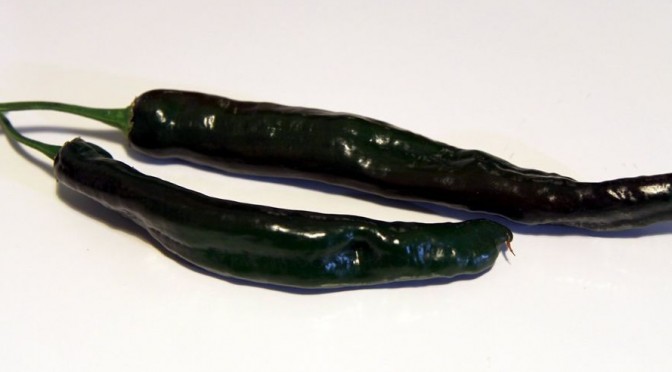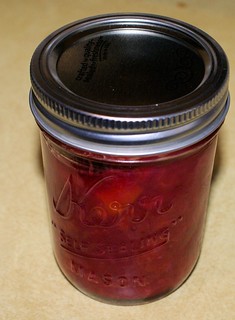My mother didn’t cook too often, usually stepping in to make something unusual or different from the standard fare that my grandmother served. Coming from a ranch family, my grandmother focused a lot on basic ranch food, meat and potatoes, chicken and hearty food. Mother liked to bake the unusual breads, the different cultural dishes. One of the things that she did every now and then was to make from-scratch enchilada sauce. I remember her coming home from a trip across the border with a bag filled with dried, very dark chiles. She pour boiling water over these and let them sit until they were soft, then put them through a sieve using a large pestle to mash them forcing out the chile juice and pulp that formed the base for the sauce. I believe that the chiles she used were Pasilla peppers.
When I began looking into the background of these peppers, I found there is a bit of confusion about what exactly a pasilla pepper is. Several sites that sell them and Wikipedia are adamant that pasilla, also called chile negro, are the dried chilaca pepper. This is a long, narrow pepper in the Capsicum annum family. It is very dark, almost a chocolate brown color when dried and I am pretty sure these are the chiles that my mother used for her sauce. Like many chiles, it ranges from mild to a middle of the range hot.
However, it seems the California camp has muddied the culinary waters a bit as grocers and cooks in California call the dried form of the poblano chile a pasilla also. This creates two lines of thinking in regards to what a true pasilla is. A couple of recipes I read even include the ancho chile as pasilla, when an ancho is actually the dried form of the poblano. It’s clear that cooks aren’t certain what pasilla is. The word pasilla, pronounced pa-see-ya, translates to “little raisin”, which more properly describes the dark brown chilaca when it is dried.


For cooking purposes, any dried chile will work to make enchilada sauce. The different chiles used will alter the taste and hotness of the sauce. Commercial chili powder uses a variety of chiles, such as ancho, jalapeno, New Mexico Hatch and pasilla. The chili powder is also excellent in making Tex-Mex Chili or any other kinds of stew chilies. One famous chef uses chili powder as the base for his enchilada sauce, so it can be a simple process to make homemade sauce or you can start from the dried peppers. One thing is pretty certain, it will be thicker and more flavorful than any canned enchilada sauce you buy.
Nutrition Information per 1 oz (28 grams) of pasilla
Calories: 97 Fat: 4.0 g Net Carbs: 6.0 g Protein: 3.0 g
Keep in mind that once pressed to get the liquid and pulp out, the nutrition value may decrease somewhat, but for calculating the recipe, it’s best to count the number of peppers rather than the finished quantity of sauce to be on the safe side.
Recipes:
So far, I haven’t tried making homemade enchilada sauce, but with Cinco de Mayo just around the corner, I am thinking I will give it a try. At least, I’ll make one beginning with chili powder or possibly one recipe that uses chipotle peppers, which you can buy canned in their sauce. So, I will refer you to a couple of recipes from other sites.
This recipe for Irma’s Red Enchilada Sauce starts with dried pasillas and dried Ancho or New Mexico chiles. If the pasillas are very crisp, they may already be roasted and you don’t need to roast them a second time.
Here’s a picture-by-picture recipe for Homemade sauce on Instructables using California or Hatch chiles.
And this is the Chipotle sauce recipe that is a little simpler.
Coming next month, I will put up a low carb recipe for enchiladas using low carb whole wheat tortillas instead of corn tortillas and homemade enchilada sauce in time for Cinco de Mayo! (That’s the 5th of May celebration for those not familiar with Mexican customs.)
All comments relevant to my posts are welcome. SPAM is not. If the post has nothing to do with my site content, it will not be posted.
Information for this article came from Wikipedia, Eat More Chiles, and Spices Inc
Top photo of pasillas is from Wiki Commons, used with permission- “Fresh chilaca chilies” by Jonathanischoice – Photographed on my kitchen bench. Licensed under CC BY-SA 3.0 via Wikimedia Commons –




 Crisp Cucumber Salsa
Crisp Cucumber Salsa
 Springtime Coleslaw
Springtime Coleslaw Strawberry Chicken Salad
Strawberry Chicken Salad Texas Style Turnip Cauliflower Salad
Texas Style Turnip Cauliflower Salad




